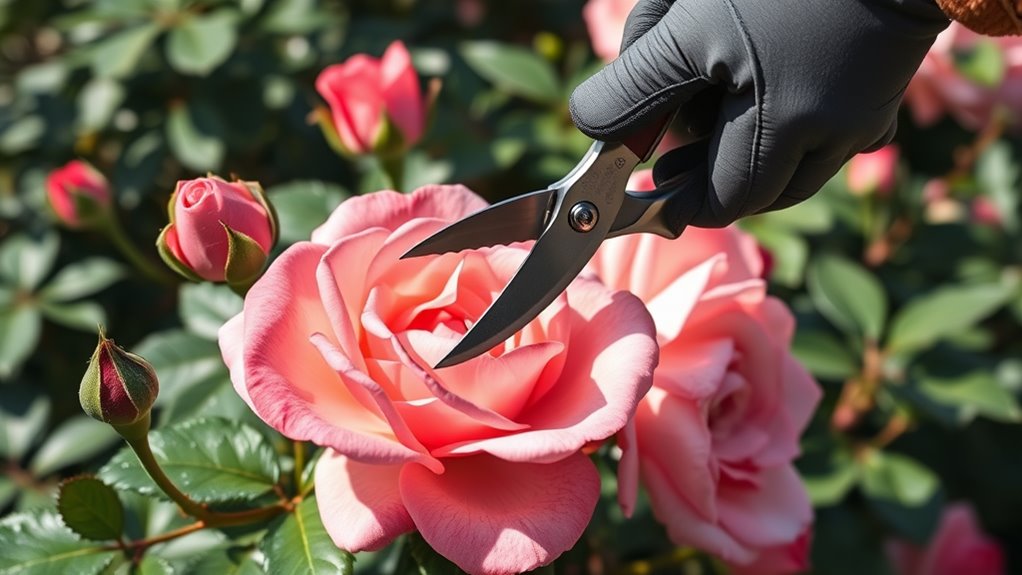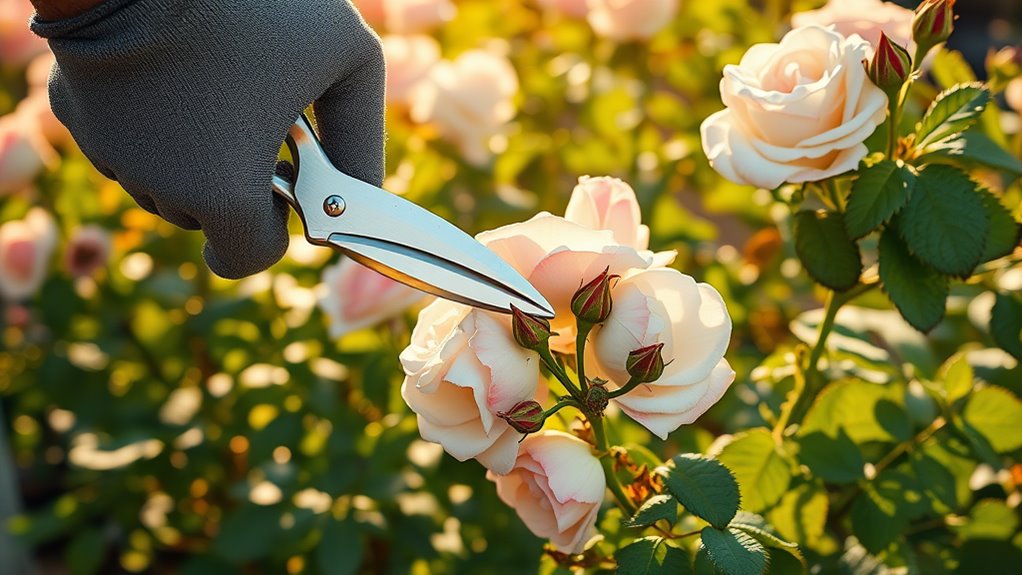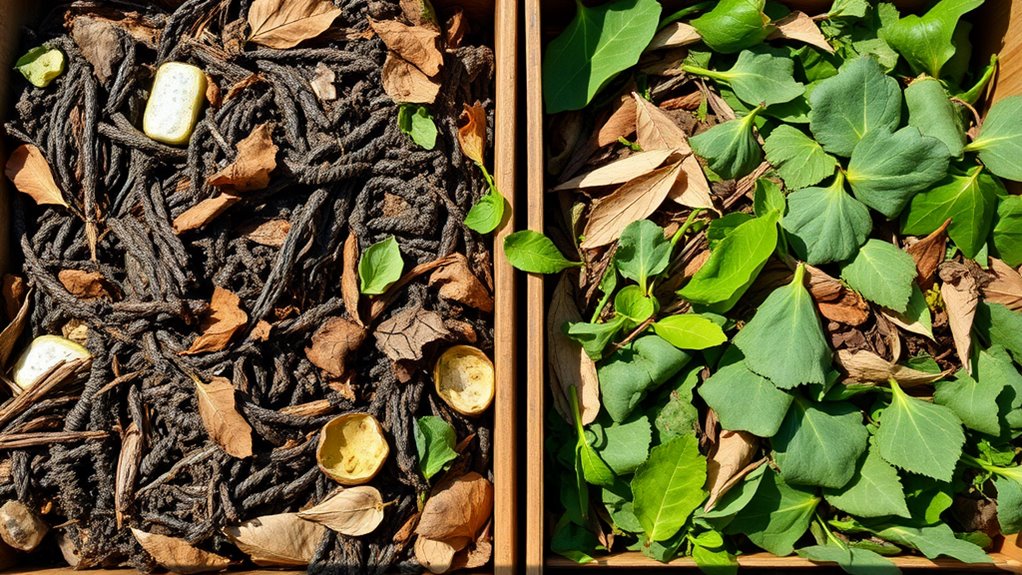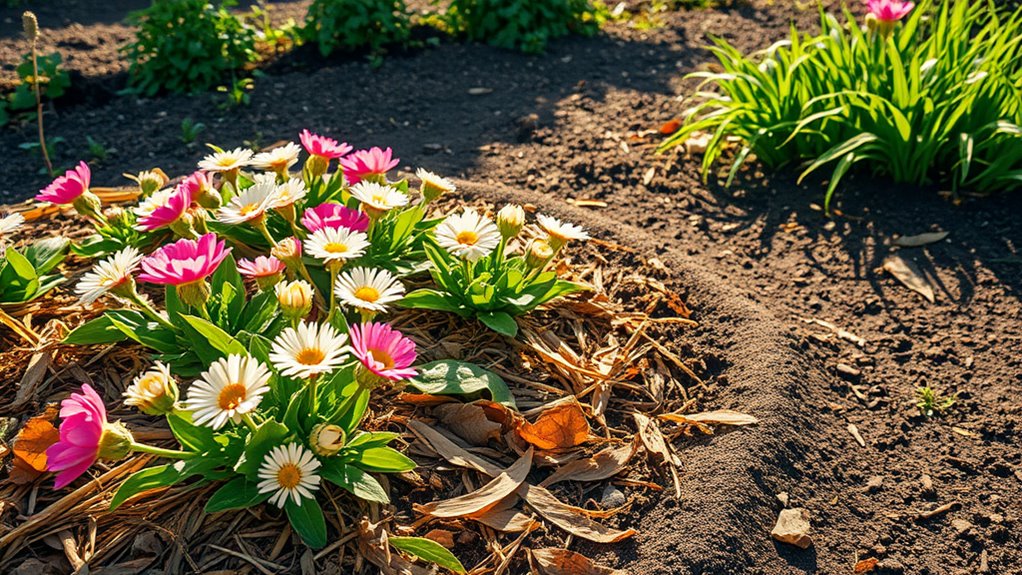My Secret Weapon for Bigger Blooms – It’s All in the Cut!
You’ve got a secret weapon for bigger blooms: deadheading. By snipping off faded flowers, you’re redirecting your plant’s energy to fuel new, vibrant growth and extend the flowering season. Grab sharp bypass pruners and cut in the early morning for clean, precise results, while avoiding mistakes like dull blades or poor timing. Master these techniques, and you’ll uncover even more ways to keep your garden bursting with color.
Key Takeaways
- Deadheading faded flowers redirects energy to new buds, resulting in bigger blooms.
- Use sharp bypass pruners for clean cuts that minimize plant damage and promote growth.
- Cut flowers in early morning when hydrated to enhance vase life and blooming potential.
- Avoid dull blades to prevent stem tears and infections that hinder flower development.
- Schedule regular deadheading sessions to maintain plant health and encourage prolific flowering.
What Is Deadheading and Why It Works
Deadheading is the simple act of snipping off faded flowers from your plants, a technique that redirects their energy from seed production to new blooms. This method can lead to bigger blooms throughout the growing season.
By mastering deadheading techniques, you encourage vigorous growth and prolific flowering, as plants focus resources on fresh buds instead of seeds.
For perennials, you pinch or cut just above a leaf node to stimulate branching; with annuals, you remove entire spent stems to promote repeat blooms.
This practical habit extends your garden’s vibrancy, preventing disease and maintaining neatness, so you enjoy a fuller, more colorful display all season long.
By applying these flower care hacks, you can enhance the flowering period and achieve even more vibrant blooms throughout the season.
Choosing the Right Tools for the Job
To keep your deadheading efforts effective and safe, you’ll need just a few key tools tailored to the job.
Start with sharp bypass pruners for clean, precise cuts on thicker stems, minimizing damage and encouraging new growth.
Add precision snips for delicate flowers, allowing you to target faded blooms without harming nearby buds.
Protect your hands with durable gardening gloves, shielding against thorns and pathogens.
Always choose ergonomic tools that fit your grip to reduce fatigue, and maintain them by regularly cleaning and sharpening blades to ensure hygiene and longevity.
This setup keeps your garden thriving. Additionally, learning about pruning methodology can help you maximize the effectiveness of these tools.
Incorporating essential pruning techniques can further enhance your garden’s growth rate.
Identifying the Best Time to Cut
While you’ve prepared your tools, pinpointing the best time to cut your flowers ensures optimal results and healthier plants.
You should aim for early morning, when stems are fully hydrated and temperatures are cooler, reducing stress and wilting. Check for buds that are partially open but not fully bloomed; this promotes better vase life and encourages more growth. Drawing from expert insights, you can refine your pruning approach for superior plant vitality and extended blooming periods.
Avoid cutting during midday heat or after rain, as these conditions can damage tissues or introduce diseases. Monitor weather forecasts and plant signals, like firm stems and vibrant colors, to time your cuts precisely for maximum blooms next season.
By mastering this timing, you’ll unlock the essential flower care secret for thriving blooms, ensuring your plants flourish with lasting vitality.
Step-by-Step Techniques for Different Flowers
Different flowers demand tailored cutting techniques to boost their vase life and promote vigorous regrowth. By adopting a specific pruning habit from garden transformations, you can achieve healthier plants and more vibrant displays.
For roses, you angle your cut at 45 degrees just above a bud eye, using sharp shears to minimize damage and spur new growth.
With tulips, make a straight, clean cut at the base to enhance water absorption—dip the stem in cool water immediately.
Lilies require an angled snip below the flower head, removing lower leaves to prevent bacterial buildup.
Always sterilize tools between cuts for hygiene, ensuring precise, healthy blooms that thrive post-harvest.
Experiment to master these methods.
Just as pruning tomatoes has shown a 50% increase in yields, these flower techniques can similarly enhance bloom production.
Signs Your Plants Are Ready for Pruning
You’ll know your plants are ready for pruning when you spot new growth emerging, signaling a prime time to encourage fuller blooms.
To achieve better outcomes, remember that avoiding common gardening mistakes is crucial for maintaining plant vitality.
If overgrown branches are crowding the structure, you’ll need to remove them to improve air flow and light exposure.
Identifying these indicators early lets you act precisely and keep your garden thriving.
Additionally, understanding pruning myths is key to avoiding errors and achieving the best plant health.
New Growth Visible
As new growth emerges on your plants, it’s a reliable indicator that they’re primed for pruning. This fresh growth, with its bright green leaves and tender shoots, signals a surge in vitality, making it the perfect time to enhance bloom potential.
You’ll spot it as lighter-colored stems and new buds forming, showing the plant’s energy is focused on expansion. Prune now to redirect resources, promoting stronger branches and more flowers.
Check regularly for these signs—weekly inspections help you act precisely, avoiding missed opportunities while maintaining plant health and vigor. Use sharp shears for clean cuts.
Overgrown Branches Present
Overgrown branches signal that your plant’s structure is becoming unwieldy, often crossing or crowding the canopy and reducing airflow.
You’ll notice branches rubbing together, which damages bark and invites pests or diseases like powdery mildew. If your plant looks unbalanced, with elongated stems blocking light to inner leaves, causing yellowing or drop, it’s ready for pruning.
Overly dense growth traps moisture, fostering rot, while top-heavy limbs risk breakage in wind. Prune these signs promptly to redirect energy to blooms, enhance air circulation, and promote healthier structure—check your plants bi-weekly for best results.
Common Mistakes to Avoid When Cutting
When you’re pruning your plants, avoid the mistake of incorrect timing, as cutting too early or late can stress them and hinder blooming. By incorporating insights from common mistakes in herb care, you can promote healthier and more resilient plant growth.
You’ll also want to steer clear of using a dull blade, which tears stems instead of making clean cuts and invites infections.
To enhance your flower’s health and beauty, incorporate a weekly session into your routine, allowing for efficient maintenance with minimal effort.
Incorrect Timing
Although mastering cutting techniques is essential, mistiming your prunes can undermine plant health and bloom potential.
You might prune too early in spring, removing buds that could have produced larger flowers, or cut in late summer, spurring vulnerable new growth before winter. This stresses plants, inviting diseases or poor recovery, ultimately shrinking blooms.
Instead, time your cuts during dormancy—such as late winter for roses—to allow energy redirection toward flowers.
Always consult your plant’s specific cycle; for instance, avoid fall pruning on perennials to prevent bud loss.
Precise timing maximizes vibrant results.
Dull Blade Use
Using a dull blade can sabotage your pruning efforts and harm your plants in ways you mightn’t expect. It creates jagged cuts that invite diseases and pests, while making your work less efficient.
To avoid these pitfalls, always keep your tools sharp. Here’s why it matters:
-
Jagged edges: Dull blades tear plant tissues, exposing them to infections and slowing healing, which stresses your blooms.
-
Increased risk: You’ll apply more force, heightening the chance of slips that damage plants or injure you.
-
Poor recovery: Uneven cuts disrupt nutrient flow, reducing flower size and vitality, undermining your efforts for bigger blooms.
Long-Term Tips for Sustained Bloom Growth
While short-term pruning boosts immediate blooms, you’ll sustain vibrant growth over time by implementing a few key strategies that prioritize plant health and resilience.
First, schedule biannual deep pruning to remove dead wood and promote airflow, preventing diseases.
Maintain balanced fertilization—use organic compost every six months—to nourish roots without overfeeding.
Monitor soil pH and moisture levels, adjusting irrigation to avoid root rot.
Integrate mulching to retain moisture and suppress weeds, enhancing long-term vigor.
Track seasonal responses in a journal, tweaking cuts based on bloom patterns for optimal, enduring results.





